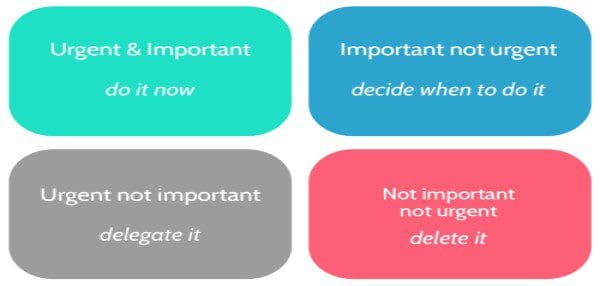
5 Tech-Based Tasks Small Businesses Should Outsource
August 3, 2021
Business Tasks Matter
September 19, 2021As entrepreneurs, we’re constantly forced to play technology catch-up in an effort to stay connected, informed, and available (to our clients). It’s mind-spinning to know what we need, where to get it, and how to use it. So the first thing I’d recommend is to cut through all the clutter and focus first on the basics and build a solid foundation.
I’m a gadget freak; I grew up as a kid waiting for the future to arrive: it had always seemed just one more year away. My first cellphone [in 1986] cost $3,000 and $1 per minute, but I could envision everyone having the “communicator” like the crew aboard the U.S.S Enterprise had.
When PDAs were introduced I resisted the urge to buy a Palm — because I knew that a single unit with PDA, phone, and music was just a year away. O.K., so it took a little longer than I expected. But finally, practical, robust, and useful technology is finally here, and affordable — both in mobile apps and web cloud-based services.
Where to start?
Incorporation and business operating certificates
What type of incorporation you do depends on what sort of business you are: sole proprietorship, partnership, corporate structure, etc. Do you have investors, or not? These all have an impact on whether you set up your business as a C-corp, S-corp, Limited Liability Corp (LLC), Limited Liability Partnership (LLP), or a Non-Profit.
You also have to take into account where your clients are located, what type of clients they are (B2B, B2C, wholesale, and/or retail, and what your future plans are. For example, a local business may have big dreams of expanding to multiple locations, or setting up franchises, while a technology company might envision going public.
For more information, talk to your accountant or financial advisor, but first, make sure that they have the expertise required to guide you.
For years many have chosen to incorporate in the state of Deleware; it provides strong corporate liability and security protections. This article in Entrepreneur Magazine addresses the pros and cons of Deleware incorporation. Miami and Nevada are also popular places to incorporate. If you need assistance determining how and where to incorporate, and identifying which, if any, additional business authority certificate you may need, talk to our business and CPA consultants.
The Needs you may have
No matter what type of entrepreneur you are, and regardless of whether you have lots of employees, or are a one-person company that only needs to communicate with contract-agents vendors, and clients, you’re going to need a suite of basic tools:
- video conferencing
- document management
- spreadsheet,
- telecommunications
- calendars [for appointment and project workflows]
- domain (URL), and web hosting,
- a website
- task management
- social media presence
- accounting and billing software
The more integrated your software is, the less cumbersome it is to manage all your applications and tools. When I set up a new company, I decided to take the time to look around and find the right bundle of tools to fulfill the needs of my business.
Price was certainly a consideration, and therefore I didn’t even look at costly offerings; I’m a grassroots bootstrap type of entrepreneur, so I needed something that was cost-effective, would help keep me organized, and that I could get up and running quickly.
After attending trade shows, talking to a lot of people, reading articles, and testing things, I settled into a few basic services that so far have met my needs. Perhaps they will serve yours.
BUILDING A WEB PRESENCE AND COMMUNICATION/MANAGEMENT SUITE
Business Set-Up – Stage II
1) Website presence: you’ll need a URL (domain name), website, and a hosting platform. i2weservices.com is an easy-to-use domain management platform with 24/7 support.
Once you set up a free account, use the search box on the homepage to find and secure a domain name: note that there are many types of extensions to choose from; such as .com, .org, .biz, TV, .me, .co, and .us — to name but a few (they range from $3.00 to $49 per year). Once you secure (or transfer) your domain name(s), you can then also secure and manage a hosting account within that same account (from $3.99 – $14.99 per month). Or, contact us for hosting on our privately managed servers.
DON’T create an email account here as it will interfere with step 2 below.
For your website, there are many website builders out there, including WIX and others. But you don’t own those, you merely lease them on a monthly basis. Preferably, I’d recommend owning your site, using open-source software like WordPress, Joomla, or Drupal, Moreover, with these, you can modify them to your needs. Find out more. Or talk to our consulting department.
2) Email and a suite of robust integrated tools. After looking around — a lot –, I zeroed in on Google Apps for business for several reasons: it was only $5 per year (per user), can accommodate and organize multiple domains with one login at no extra cost, and you can have limitless aliases. It also has tons of free integrated Google products, and a third-party marketplace loaded with other software tools that ‘plug into’ the Google system. And, if you’re a one-man show, you can still collaborate with outside third parties for no additional cost.
Before setting up your account, be sure to have an existing outside email account that doesn’t use your domain name — like @gmail, @yahoo.com, @Aol.com or @otherdomain.com, for example.
Once your account is active, login to the business Gmail and in the gear, icon drop-down select Manage this domain. In the dashboard click Domain Settings and make sure everything is correct. Click Appearance and you can upload your business logo that will be branded throughout your Google apps. Next, go to USERS and you’ll see a place to add domains, i.e. info@ sales@, etc. Need help? Ask us.
Now you’re also set up to use business.google.com, analytics, and more.
If you have more than one domain, you can add others later. My first Google account has one main domain and one user, with three other domains set up aliases. Since then we’ve expanded to 25 users.
As an entrepreneur, I found the system very convenient to manage multiple brands. The core Google system, for which there is 24/7 live support, came with Gmail (branded with my domain, i.e. you@yourdomain.com), Calendar(s), Docs (tools and storage for documents, spreadsheets, drawings, and presentations), task lists, Groups, and Sites [that you can use to build intranet sites within your organization; best if you have multiple employees].
It took me time to figure out exactly what I needed and what I didn’t, but all in all, I found it pretty intuitive and easy to set up (if you need help setting up your Google Apps for business accounts, contact us.
As a sole entrepreneur, you’ll find the system an easy way to have all the things in your business universe easily organized and manageable, and tools to easily be able to collaborate with third-party clients and/or vendors. A small business, in addition to the above, will see increased productivity with real-time collaboration capabilities between their employees inside the system.
Automation is to your money what compound interest is to your money! –
Rory Valden
THIRD-PARTY PROGRAM INTEGRATION
You’re going to likely need a few additional management tools to run your business. Namely sales leads, project management, task management, and accounting/billing tools.
We can help with that, as we’ve experimented with most of them. You can integrate everything (40 modules including CRM, accounting, subscription management, projects, HR, video chat, booking, and more) with one.zoho.com. If you only need a PM, there are many in the Google Marketplace, although https://todoist.com is easy, integrates with Google, and is only $5 a month. For something more robust, TeamWork.com is another very google and robust tool. Another is Bitrix is a leader and has a free version.
Project Management: In addition to To-Do List, TeamWork, and Bitrix24, there are others in the Google Marketplace, such as DO and RapidTask. I tried AffinityLive but found it a bit cumbersome and geared more towards in-house project management, and it didn’t fully address how I needed to interact with third parties. Mavenlink is another paid app that is potent, but again, the free version DO might meet your needs. ViewPath is another.
CRM (Customer Relations Management): Again, ZoHo has a stand-alone CRM, as well as incorporating it into one.zoho.com, but there are others. If you only need a CRM for sales mining, you might like https://pipelinecrm.com, Nutshell.com, or HubSpot (they have a free CRM version and a very robust pay version that includes marketing tools. Depending on whether you’re a one-man show or have multiple people using the CRM, there are many to choose from. MyERP.com is potent and an all-in-one app, but has virtually no support, so you have to do a lot of reading to figure it out. Solve360, SmartSheets, and GlassCubes were all relatively easy to set up and populate.
Accounting/Billing: Accounting is one of the most important aspects of your business; yet many entrepreneurs overlook it, thinking that after they make money then they’ll look into it. BIG MISTAKE. You need to set up this foundation first. As mentioned, ZoHo Books is a stand-alone tool (or as part of the one.zoho.com suite). But as a stand-alone, there are also QuickBooks and Freshbooks. Our CFO is a career CPA with an MBA in finance, so talk to our consulting team if you need help not only installing and setting up the software but also configuring the Chart of Accounts. https://i2webservices.com/consulting
Social Media It is virtually impossible to run a business today without a social media presence. There are many, but the big leaders are Facebook, Linkedin, Instagram, Twitter, and YouTube. And which you build your social media campaigns around depends on what you’re selling, and to whom. You’ll also need to research the best times of the day to post, as each has its own most frequented. Once you’ve made the determination of which to use, you need to make sure the info on each is consistent. Messaging is important! So here are some simple steps:
- Build a brand bible. This includes your tagline, your elevator pitch, which changes depending on B2B vs B2c. (Ask us how)
- Develop the first set of post contents. This can be articles on your website, memes, surveys, and links to 3rd party links of interest for your customers. Funny works too.
- Set up a social media management system. Hootsuite is popular, as is eClincher as well as many others,. Review them to see what works best for you.
- Post a minimum of three times to week, better to post 5-7 days a week.
- Engage: make sure to review the comments and respond. Build a relationship.
- Make sure your sales posts are only 1 in 7 posts. You want to establish yourself as an authority in your industry through education and content of interest.
- Use A/B testing to try out social boost ads. See what your followers respond to and then drill down to righten the message.
If you need help with any of the above. contact us.
Creating strong communications and operating systems is key to launching a successful business plan. If you do decide to try any of the things listed above, please be sure to come back and let us know how they worked — or didn’t work, for you.
Did you miss Business Set-Up Stage I? Read it here.
Also, consider talking to creative agencies that can provide many of the services listed in this article.




